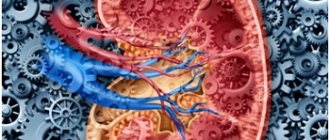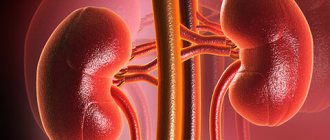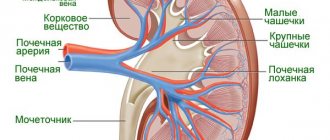Kidney failure is a condition in which the kidneys cannot cope with their function. Their ability to remove metabolic products from the blood, control fluid balance in the body, electrolyte levels, and acid-base balance is impaired. With prolonged renal failure, blood pressure increases and the level of red blood cells in the blood decreases (normally, the kidneys produce the hormone erythropoietin, which stimulates the formation of new red blood cells).
Our expert in this field:
Isaev Artur Ramazanovich
Oncologist, urologist, surgeon
Call the doctor
Kidney failure can develop at any age, but is most common in older people. It can be caused by various diseases. There are two types of renal failure, in which treatment approaches and prognosis differ:
- Acute kidney failure (AKI, acute kidney injury) is a condition in which loss of kidney function occurs quickly, over a period of days or weeks. Nitrogenous metabolic products accumulate in the blood (this condition is called azotemia), and the water, electrolyte, and acid-base balance is disturbed. Some patients experience decreased urine output, but this is not necessarily a symptom. Treatment of acute renal failure is aimed at combating the disease that caused this condition and restoring water and electrolyte balance. Some patients are indicated for dialysis (artificial kidney machine).
- Chronic renal failure (CRF, chronic kidney disease) is a gradual deterioration of kidney function over a long period of time. At a later stage, this condition manifests itself in the form of nausea and vomiting, loss of appetite, severe weight loss, fluid retention in the body, stomatitis, burning sensation and metallic taste in the mouth, decreased mental clarity, frequent urination at night, damage to peripheral nerves, seizures, epileptic seizures. Treatment is aimed at combating the disease that caused kidney failure, correcting water-electrolyte and acid-base balance, lowering blood pressure, and eliminating anemia. In later stages, dialysis is used and kidney transplantation is performed.
Severe forms of acute renal failure often lead to the death of patients. Chronic kidney failure progresses constantly, and all that can be done is to slow its progression. With the advent of dialysis and kidney transplantation, patient survival has increased dramatically. The Medicine 24/7 clinic uses the most modern treatment methods.
Request a call back. We work around the clock
Etiology and pathogenesis of chronic renal failure
The cause of chronic renal failure may be chronic disease of the kidneys, urinary tract or other organs.
- Primary damage to the glomerular apparatus (glomerulonephritis, glomerulosclerosis);
- Pathology of the tubules (chronic pyelonephritis, chronic intoxication with lead, mercury, hypercalcemia, Albright's tubular acidosis);
- Infectious diseases (malaria, sepsis, bacterial endocarditis, viral hepatitis B/C);
- Systemic diseases (systemic lupus erythematosus, cryoglobulinemic vasculitis, cutaneous leukocytoclastic vasculitis, Wegener's granulomatosis, periarteritis nodosa);
- Metabolic diseases (gout, diabetes mellitus, amyloidosis, hyperparathyroidism);
- Nosologies that cause obstruction of the urinary tract (urethral strictures, urolithiasis, formations of the prostate, ureters, bladder);
- Lesions of the renal parenchyma of a secondary nature caused by vascular pathology (essential arterial hypertension, malignant arterial hypertension, renal artery stenosis);
- Hereditary diseases (polycystic kidney disease, hereditary nephritis, phosphate diabetes, Fanconi syndrome);
- Medicinal nephritis.
Development of the disease
At the initial stage, renal failure occurs in a latent form and the patient may not be aware of kidney problems for a long time. Nevertheless, exacerbations of an acute or chronic nature lead to disturbances in filtration and excretory functions and further destruction of renal tissue.
Medical recommends that all older people undergo preventive diagnostics in order to identify and treat various disorders and pathologies in the early stages.
Diseases such as glomerulonephritis, pyelonephritis, diabetes mellitus, cysts and stones in the urinary organs are quite common in older people and require timely diagnosis and treatment.
Classification of chronic renal failure
The stage of chronic renal failure is determined by the glomerular filtration rate, which is calculated using certain formulas (MDRD, Cockcroft-Gault), for the processing of which the sex, age and weight of the subject are required.
There are four stages of chronic renal failure:
- Latent: practically asymptomatic, can be detected during an in-depth examination or randomly. Already at this stage, the glomerular filtration rate decreases to 50-60 ml/min, however, due to the compensatory ability, renal function is practically not impaired. In clinical urine analysis, slight proteinuria and, occasionally, the presence of sugar may be observed. Detection of chronic renal failure at this stage is prognostically favorable.
- Compensatory stage: glomerular filtration rate is reduced to 49-30 ml/min. General symptoms are diagnosed (weakness, thirst, fatigue, dry mouth, polydipsia, polyuria). Pathological changes in the tests are also determined: in a clinical urine test proteinuria, isosthenuria are noted, in a biochemical blood test - an increase in the level of creatinine and urea, minor electrolyte shifts are observed.
- Intermittent stage: glomerular filtration rate is 29-15 ml/min. Symptoms of the disease that caused chronic renal failure are pronounced, changes in laboratory parameters are observed (azotemia, proteinuria, anemia increases). With adequate treatment, the patient's condition improves.
- The terminal stage is divided into four periods:
- I-glomerular filtration 14-10 ml/min. Diuresis without stimulation up to 1.5 l/day. Uremic syndrome and electrolyte disturbances develop. Medication correction of electrolyte balance is possible;
- IIa - oliguria develops (up to 500 ml/day). Severe electrolyte changes are observed (hyperkalemia, hypernatremia), metabolic acidosis and edema syndrome develop. The functions of the cardiovascular and respiratory systems are subcompensated;
- IIb - the same phenomena are observed, and changes in the cardio-respiratory system are also added (pulmonary edema, acute left ventricular failure, rhythm disturbance, conduction disturbance);
- III - terminal uremia develops, accompanied by decompensation of the cardiovascular system. Treatment at this stage is ineffective.
Damage to organs and systems in chronic renal failure
- Anemia is a symptom characteristic of most patients in the terminal stage of the disease. The development of anemia is associated with impaired production of erythropoietin by the kidneys, thrombocytopenia, and coagulopathy associated with heparinization during hemodialysis.
- Changes in the cardiovascular system primarily determine the prognosis of the disease. About 20% of patients die from heart failure or rhythm and conduction disturbances. Arterial hypertension is one of the early signs of chronic renal failure. Arterial hypertension can be primary and secondary to chronic renal failure. Rhythm disturbances occur due to changes in electrolyte balance: hyperkalemia, hypocalcemia, hypernatremia. Chronic renal failure is also characterized by the development of polyserositis, in particular pericarditis.
- With the increase of uremia, damage to the central and peripheral nervous system occurs. Severe encephalopathy, convulsive syndrome, and coma may develop.
- The gastrointestinal tract begins to take part in compensatory mechanisms quite early in the development of chronic renal failure. The patient complains of an unpleasant taste in the mouth, nausea, and loss of appetite. Constant exposure of the mucous membranes to the products of nitrogen metabolism leads to the development of stomatitis, gastritis, and enterocolitis.
- Hypocalcemia leads to the development of osteomalacia and osteofibrosis. A decrease in glomerular filtration rate provokes the occurrence of hyperphosphatemia. A decrease in ionized calcium in the blood serum stimulates the development of hyperparathyroidism, which causes osteodystrophy.
- The functioning of the immune system is compensated until end-stage renal failure. If a secondary infection occurs, the prognosis of the disease worsens sharply.
Complications and consequences
- Uremia (self-poisoning of the body with breakdown products of nitrogenous substances) and increasing uremic coma (unconscious state, profound impairment of the functions of the respiratory and circulatory systems) lead to death.
- Complications from the cardiovascular system : heart failure;
- ischemia (insufficient blood supply) and myocardial infarction (death of part of the heart muscle);
- heart rhythm disturbances;
- pericarditis (inflammation of the heart sac).
- persistent arterial hypertension;
Symptoms of chronic renal failure
The nature of the symptoms is associated with the primary nosology, however, with the development of chronic renal failure, the symptom complex depends on the effect of nitrogen metabolism products on the human body.
- In the latent stage, the manifestations will be of an erased nature, but when the compensated stage occurs, the patient feels weakness, fatigue, apathy, swelling of the lower extremities, face, periodic headache, nausea or vomiting. With the increase of uremia, changes in other organs and systems are noted: the skin is dry, yellowish, itchy skin is bothersome, weight loss is diagnosed, and the smell of ammonia from the mouth.
- From the cardiovascular system, arterial hypertension, pleural friction noise during pericarditis, tachycardia, various arrhythmias, hemorrhages, and the development of heart failure are observed.
- Respiratory system: shortness of breath, wet cough with congestive pneumonia, pulmonary edema.
- Gastrointestinal tract: vomiting, nausea, lack of appetite, abdominal pain, bad breath, bloating, development of ulcers, erosions in the oral cavity, stomach, intestines, bleeding.
- Musculoskeletal system: burning pain in the joints due to the development of secondary gout, bone fractures due to electrolyte imbalance.
- Nervous system: hiccups, itching, irritability, headache, dizziness, memory impairment, psychosis, encephalopathy. In the terminal stage, a coma may develop.
- Urinary system: pressing pain in the lumbar region, changes in color and transparency of urine, and the presence of edema may be observed.
Forms
The following stages of development of chronic renal failure are distinguished:
- Latent stage: the patient may not have any complaints, or he may experience: fatigue during physical activity, weakness that appears in the evening, dry mouth.
- the patients’ complaints are the same, but they occur more often;
- general weakness, fatigue, thirst, dry mouth, appetite decreases sharply, unpleasant taste in the mouth, nausea and vomiting, swelling on the face;
- Terminal stage: emotional lability (apathy is replaced by excitement), disturbance of night sleep, daytime drowsiness, lethargy and inappropriate behavior;
- the face is puffy, edematous, gray-yellow in color, itchy skin, dull, brittle hair;
- dystrophy (loss of body weight) increases, hypothermia (low body temperature) is characteristic, there is no appetite, the voice is hoarse;
- the smell of urine is felt from the mouth, the tongue is coated, the stomach is swollen, vomiting, regurgitation, often diarrhea are repeated, foul-smelling, dark-colored stools;
- other organs are affected - dystrophy (decrease in the size and volume of the organ) of the heart muscle, pericarditis (inflammation of the heart sac), circulatory failure, pulmonary edema, encephalopathy (disturbed sleep, memory, mood, the occurrence of depressive states); the production of hormones is disrupted, changes occur in the blood coagulation system, and immunity is impaired;
- nitrogenous metabolic products are excreted in sweat, and the patient constantly smells of urine.
Diagnosis of chronic renal failure
This diagnosis is made based on determining the glomerular filtration rate, the calculation is made using special formulas. Also, detailed questioning, taking an anamnesis to clarify the etiology of chronic renal failure, and additional examination methods help in making a diagnosis.
Laboratory:
- clinical blood test: signs of varying degrees of anemia, thrombocytopenia, leukocytosis;
- clinical urine analysis: hypoisosthenuria, proteinuria, presence of sugar in the urine, formed elements, bacteria;
- biochemical blood test: noticeable increase in the level of urea, creatinine, uric acid, ALT, AST, dysproteinemia, hyperkalemia, hypernatremia, hyperphosphatemia, hypocalcemia;
- urine analysis according to Nechiporenko - the presence of leukocytes, erythrocytes, cylinders;
- Urinalysis according to Zimnitsky - hypoisosthenuria.
Instrumental examination methods:
- Ultrasound of the kidneys - allows you to detect a decrease in the volume of renal tissue, a decrease in the thickness of the renal parenchyma;
- echo Dopplerography: determines a decrease in the level of blood flow in the main, intraorgan vessels;
- puncture biopsy of the kidney - allows you to make an accurate diagnosis, determine the stage, and prognosis of the course of the disease.
X-ray contrast examination methods are treated with caution, since many of them have severe nephrotoxicity and can negatively affect the course of the disease.
It is also advisable to examine the heart (ECG, Echo-X), conduct a chest X-ray, and use specialized methods for diagnosing the underlying disease (genetic tests, determination of antibodies, and so on).
Kidney functions
excretory
The nephrons (the structural units of the kidneys) filter the blood, resulting in the formation of urine.
Excreted in urine:
- Protein metabolism residues: urea, creatinine, ammonium salts, sulfuric, phosphoric, uric acids.
- Excess water, salts, micro- and macro-elements, glucose.
- Hormones.
- Harmful substances of third-party origin, including medications.
Homeostatic
Homeostasis means the balance of the internal environment of the body. The amount and ratio of vital substances (for example, water, sodium, potassium, etc.) can fluctuate only within limited limits - even a slight imbalance leads to disease.
The kidneys “monitor” that the amount of substances excreted corresponds to the amount of substances received. This maintains water-salt, acid-base, electrolytic, and osmotic homeostasis. This means that a constant volume of blood, external and intracellular fluid is ensured, the uninterrupted flow of metabolic processes is ensured, and a normal level of blood pressure is maintained.
Endocrine
This is the synthesis of some biologically active substances and hormones.
For example, the kidneys produce the hormone erythropoietin, which stimulates the production of red blood cells in the bone marrow. They also complete the formation of active vitamin D3 (calcitriol), which forms bone tissue.
Metabolic
Participation in the breakdown of proteins and the construction of part of cell membranes. Synthesis of glucose from other substances.










